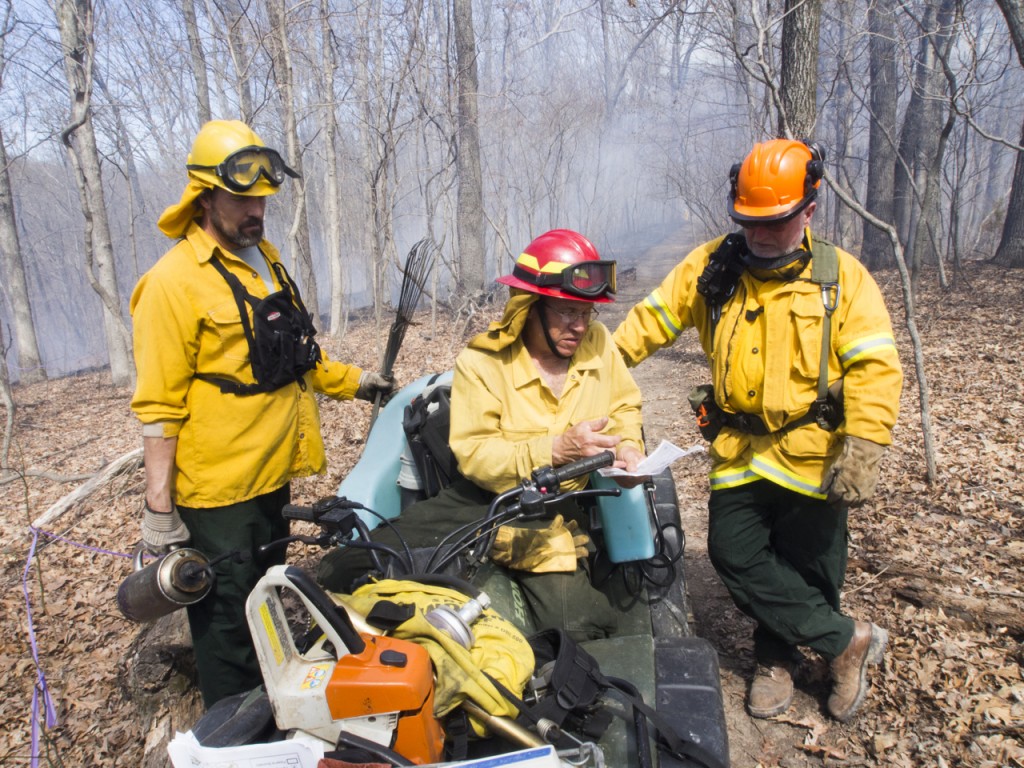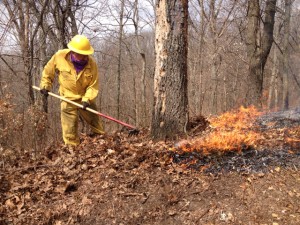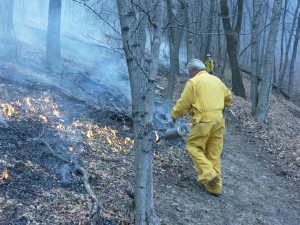Controlled Burns Are Beneficial to Area’s Natural Lands

IDNR District Forester Mark Brown, Mike Fries, Fries & Associates, and CLIFFhanger Mike McCarrin confer during the prescribed burn at White Rock Nature Preserve. Photo courtesy Tom Rollins, ThomasRollinsPhotography.com
Fire was once a common event and natural occurrence in the prairies and forests of the Midwest. Lightning was the source of naturally occurring fires, but Native Americans also used fire to clear undergrowth from forests and stimulate the growth of prairie grasses by removing thatch. Not surprisingly, native Midwestern plants depend on periodic fire to rejuvenate growth and ensure long-term survival. Modern tendencies to suppress fire allow woody and weedy invasive species to overtake our native grasses and forbs thus reducing plant and animal diversity.
Prescribed burning is used for a variety of reasons—most notably to maintain the health of an existing natural area containing native plants. Fire helps to eliminate weeds and other growth which, in turn, helps to reduce the risk of wildfire. But it also can help to restore nutrients that will enhance future plant growth.

Bob Mohr, Salt Like Point Stewardship Committee, rakes leaves from a snag to ensure that the tree -- an important resource for wildlife -- does not catch fire during a March prescribed burn at the Reserve. Photo courtesy Joann Fricke, Clifftop.
A controlled burn can take place any time between mid-October and April 1, when most native snakes, frogs and bugs have gone into hibernation or have migrated. Some fire managers prefer a fall woodland burn because the leaves haven’t yet been soaked by repeated rains or crushed from snow that has covered them for weeks on end. Oak leaves contain tannins that make them more resistant to decay, thus providing more burnable material. Oak leaves also tend to be drier and thicker than other hardwood species, making them more flammable and capable of carrying a fire. Oak and hickory trees are not bothered by the brief hot fire of a controlled burn, but woody shrubs, like bush honeysuckle, and trees, like maple and sassafras, will be top-killed.
Recently, fire managers around the state of Illinois have experimented with growing season burns in prairies to remove dead, brown thatch. The concerns about harming snakes and other critters that live in grassy areas is mitigated by the fact that the fire moves so slowly (because of the abundance of green) that these animals can move out of the way of the flames. An added advantage of growing season burning is that a smaller crew is needed to control the fire. The jury is still out on the benefits of growing season burns, but it seems to be “catching” on.

A controlled burn in a woodland improves oak and hickory tree regeneration. Photo courtesy Joann Fricke, Clifftop.
While we can plan a prescribed burn for a certain day, atmospheric conditions—temperature, humidity, wind speed and direction–must be just right for the success of a burn. No rain or snowfall for several days prior makes for good, dry conditions, but a nice rain or snow the day after a burn certainly eases the mind of the burn boss.
Speaking of the burn boss, this is the person who is responsible for writing the burn plan which includes the atmospheric conditions mentioned above as well as soil types, fuel loads and other factors that could influence fire behavior. The plan must include a smoke permit, issued by the Illinois Environmental Protection Agency, and must follow that agency’s air quality and safety regulations, including smoke abatement factors.
Diligent preparation and an attentive crew is essential for the execution of a safe and effective prescribed burn. One must not only watch the fire but also make sure that embers do not cross the fire line out of the burn unit. Becoming familiar with controlled burn equipment gives members of the fire crew the tools they need to face all types of situations that may come up during a burn. A boring burn is a good burn. This means that everything went as planned and nothing got out of control.
Please join Clifftop as we present a Controlled Burn Workshop. The presentation will feature various Clifftop board members who will cover the benefits of prescribed fire for natural areas, requirements of the Illinois Prescribed Fire Act, fire line preparation and safety and equipment used for this important part of our stewardship tool kit. The workshop will be held from 1:00 to 3:00 p.m. on January 28 at the Monroe County Annex, 901 Illinois Avenue, Waterloo. The program is free and open to the public. Registrations are required by January 26th and may be made by email to cliffmbr@htc.net or by calling 618-935-2542.
CLIFFTOP, a local nonprofit organization, is focused on preserving and protecting area bluff lands.
A version of this article appeared in the 20 January 2017 edition of the Monroe County Independent.
© 2017 all content rights reserved Clifftop NFP
Comments are currently closed.
